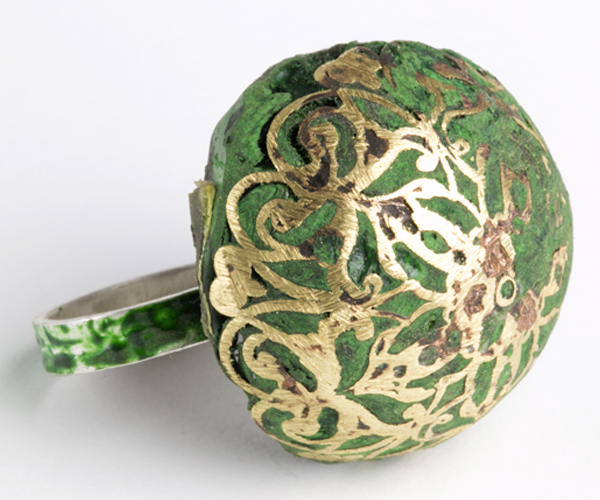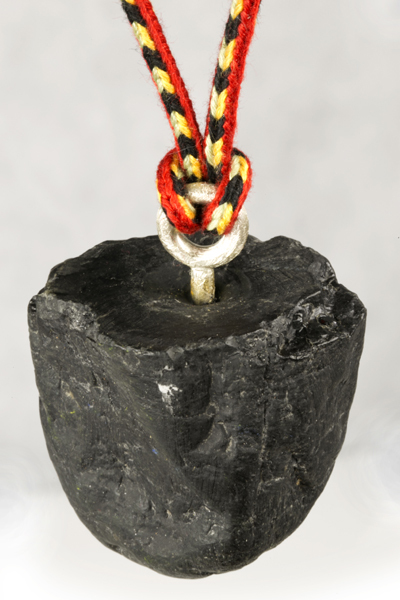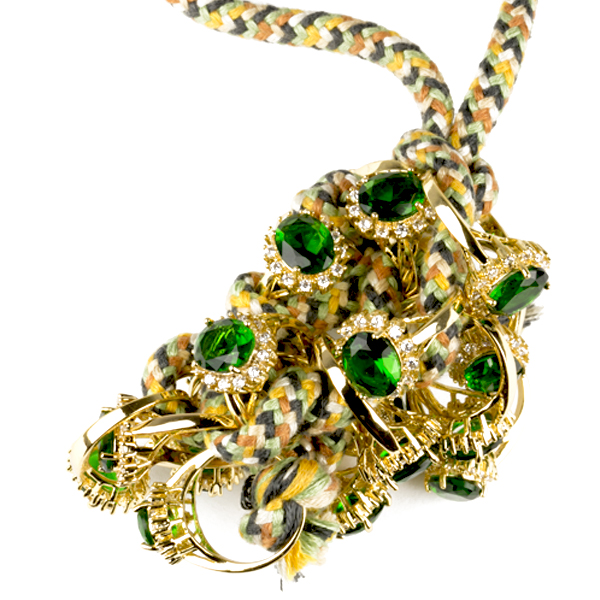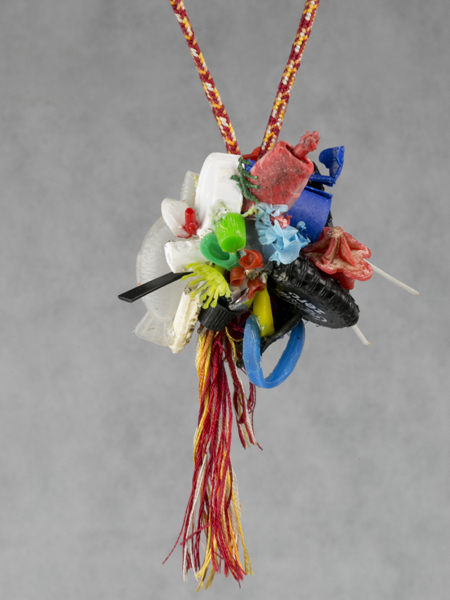Susan Cummins: What does the title of your show, Deflating Standard, mean?
Peter Deckers: This title refers to my (that is, the world’s) increasing realization that our planet is accelerating toward destruction, compounded by my frustration that neoliberalism will be incapable of finding a solution.

In a statement about this exhibit, you talked about how “value is perceived, mediated and utilized” as being one of your recurring themes. Can you explain how that thread appears in this body of work?
Peter Deckers: The work for this exhibition is largely made from low-cost and/or devalued materials that have been manipulated to increase their value or significance. Most materials in this exhibition are of nominal value, from found plastics to coal; however, there is a dash of black diamond and some silver to be found. The exhibits are all pointing toward the perception of normality, all is good and positive … business as usual.
The focus of this show is not unlike how our neoliberal society works. Neoliberalism overvalues things that in themselves have very little value. Therefore I like to use a variety of “clashing” materials that represent the perception of value. Some were chosen with a great deal of thought, and others just came through play and experimentation. I am not a purist in my design and making processes and always leave things open for chance and happy accidents. Through this process, poetic forces influence the work I produce.
Although my art process is intuitive and lyrical, the elements it taps into are not. There is an unseen and nonspecific object psychology connected to “value judgments” that can be analyzed. Most daily objects inform us about how our culture has been progressing. Each known object contains a layer of history with its own value judgment. A plastic composed pendant can be a (perceptive, conditioned) beautiful object and at the same time be ugly as a material and/or in its subject matter. This dichotomy is constantly at work for most materials and functionality. For example, I have fused bits of washed-up plastic from a Wellington beach into a ball on a chain. The composition looks beautiful, but our giant floating Pacific garbage island (also made of jettisoned plastics) is far from that. Our postmodern society looks at such issues with open eyes. The global destruction now underway can’t be hidden anymore and drastic intervention will need to happen sooner or later.
When my wife Hilda Gascard and I immigrated to NZ in 1985, we saw ourselves as “environmental refugees.” The industrial European smog, acid rain, overpopulation, and planned cruise missiles on the border of Holland made us look for a better place to live. Chernobyl had happened, so my first solo show in NZ in 1989 was therefore called Environmental Distortions. I made work based on man-made and natural disasters. It was important for me at the time to point toward environmental concerns. It was the reason for our immigration, after all. In NZ I came to realize that nature has its own increasing plan of destruction and that you cannot hide from the consequences. We all witness with increasing climate disasters that the world is on a pathway of destruction. This exhibition builds upon that in relationship to a perception of value in a more subdued fashion.

With this jewelry are you trying to increase the perception of value of costume jewelry?
Peter Deckers: To a point. The use of costume jewelry in my work plays on the fine distinctions that can be drawn between what constitutes good taste and bad taste. I find it most satisfactory that a low valued item and/or discarded materials can be reworked into a beautiful and loving object. It holds the intrinsic value of my aesthetic energy that has been formed over the years. In the end, it is that intrinsic value that remains and hopefully is passed on to an appreciative audience. I realize it is a question of judgment about how the work will be perceived in the future. However, this type of “anti-value” jewelry might not do well in the Antiques Roadshows of the future.
Common tastes of beauty, ugliness, aesthetics, and the value of provenance are all prone to cultural and historical conditionings. Our eyes and fingers can see and feel the slightest difference between material textures, shapes, etc. That information is processed in our brain through a value system filter. We all do it; we all judge. Our value system knowledge is formed by our conditioned education system, history, and culture. Value can only be compared to what we can recognize.
We do not like to be deceived or cheated. Costume jewelry has never been accepted as valuable or even being an imitation of the real. The shapes and stones are called cheap and nasty, although everything is close to the real. The dispersion and the reflection of light in glass stones is close to the dispersion in real gemstones. Our eyes can barely see that slight difference, but we perceive the two as being hugely different. This fascinates me, and I play within this weird world of value perception.
For this show I collaborated with a kumihimo (Japanese braiding) artist, Katy Corner. I responded to her colors and textures in a similar fashion to how I worked with other found materials like costume jewelry. I do not set out with any predetermined shapes, techniques, or process, and that opens up exciting adventures of discovery. After making jewelry for more than 40 years, I can proudly say that I still do not have a set way of working. I refuse to trap myself in a single direction, although I do have an “accent” in my working process that is created by my industry training. I don’t find that a very attractive “accent,” however. I believe that knowledge or focus solely based on technique kills creativity and the enjoyment of making. To keep fresh, I constantly rework my value concepts, and that provides the context that determines what my intuition needs to do.

As a tutor at Whitireia University, what do you regard as one of your most challenging assignments?
Peter Deckers: As tutors, we need to stay true to the task of nurturing the next generation of artists, and that is:
1) not killing talent
2) providing a creative and progressive program that is challenging and stimulating; that is student-focused; and that avoids creating a “house style”
3) giving regular feedback that is inclusive, builds upon students’ development, is not a conversation stopper
4) listening to the ideas and philosophies of the students and giving feedback from that position
5) avoiding bringing into the feedback our own tastes, philosophies, and values (here I am challenged by my own value conditioning philosophy)
6) assisting everybody who is passionate, has a vision, and is energetic.
In 2018, Whitireia Art will move to a big new building in central Wellington. We are working with an architect to make the design of the spaces fit with our philosophy. It is a challenge, because budgets, interest groups, and our philosophy do not necessarily share the same objectives.
Besides making your own work, you have been very busy with other projects. These include curating projects like Deep, Deeper Still, Jewelry Out of Context, HandStand, and HANDSHAKE. What interests you about curating?
Peter Deckers: Around 2000, I realized that not much was happening in New Zealand for emerging artists and projects that stepped outside the norm. As a good immigrant, I pioneered my own projects and fortunately managed to find sponsors, locations, and colleagues along the way to help them become a reality. This approach was not born out of ambition, but more out of necessity.
Your project called HANDSHAKE paired young New Zealand makers with well-developed jewelers from around the world. Tell us about how this worked. What were the results?
Peter Deckers: HANDSHAKE is a mentoring and exhibition project involving emerging jewelers from New Zealand being matched with their chosen idols from across the globe in mentoring roles. The project began in February 2011, with a series of (progressive) national and international exhibitions. HANDSHAKE is now in its second iteration—HANDSHAKE 2—with professional development workshops and master classes aiding the mentees in their development for exhibitions and the growth of their professional practice. Each new HANDSHAKE exhibition is progressive, and the feedback before and after gives opportunities for new thinking, making, presentation, and networking. Each HANDSHAKE project has its own website where the participants report on the progress of their research and development.
In 2016 a third HANDSHAKE project will bring together selected creative enthusiasts from the former HANDSHAKE 1 and 2 projects. Next to the development of new bodies of work, HANDSHAKE 3 will also focus on collaboration in its widest sense, and will be accompanied by a fresh series of exhibitions at prestigious national and international galleries. The participants are selected through an open call, and a selection panel is built from internationally renowned experts from a variety of art practices.
It is a fine-tuning process and we have to ask if a mentorship would further the artist’s practice, whether they have the drive to take risks and experiment and to become a mentee. The project relies on the concentrated focus of each mentee, and on the relationship and knowledge of the participating mentors.
HANDSHAKE 2 is currently at Sydney’s Stanley Street Gallery as part of the JMGA 2015 series of conference exhibitions. Read more on HANDSHAKE 2 here.

You also were instrumental in organizing JEMposium, an international symposium. Why did you organize this, and what issues did you hope to explore?
JEMposium was an attempt to create creative dialogue and unity among New Zealand and Australian makers. Ten years ago we had symposiums every so often, and the odd conference. They always sparked off energies and synergies. In more recent times, nothing was happening so, I created my own, by forming a steering group and finding funding for a Wellington conference. JEMposium echoes three Whitireia jewelry papers: one based on the development of ideas, one based on ideas explored through materials, and an exhibition/creative enterprise paper. These are the questions we explored through the three different topics:
1) Ideas into materials topic:
How do processes and practices formulate creative platforms?
What are the methodologies that allow an artist to materialize an idea?
Artists introduce and discuss the different processes they use to transform theory into practice.
2) Materials into ideas topic:
How do artists use innovative materials to yield unexpected ideas? Or, how do traditional materials generate extraordinary ideas?
Artists present and discuss the impact ideas and design processes have on the generation and execution of creative solutions.
3) Distribution topic:
What happens with the finished product that comes from the artist’s workshop? This session examined a variety of distribution approaches:
a) Traditional: the role of museums, galleries, and collectors
b) Alternative: new and unusual forms of distribution, such as projects and alternative sites for jewelry presentations
c) Documentation/communication: how do critical writing, photography, Internet/blog and catalogs impact on sales and distribution of jewelry?
What do you think about the current state of international contemporary jewelry? Some people are very pessimistic. Are you?
Peter Deckers: Not where I operate from. In New Zealand, contemporary jewelry is getting stronger by the day. It is still well supported by the New Zealand arts funding agency, galleries, educational providers, and museums. These elements need to go hand in hand to make it work.
Lately the international focus has somewhat shifted away from central Europe to other countries, like northern Europe, Asia, South America, and the USA. There are two upcoming events here in New Zealand and in Australia where visionary individuals will work together to make a splash (Wunder week in Auckland and Radiant Pavilion in Melbourne).
There are, however, definitely elements of concern that are undermining those who are passionate about contemporary jewelry. Since its birth, contemporary jewelry has never been a mainstream art form and it relies therefore on strong individuals for its distribution, funding, and promotion. Those in the know are few and far between. However, the contemporary jewelry world is still in its pioneering stage and that will always attract certain passionate individuals. Unfortunately, almost nobody can make a decent living in it, and therefore those who are passionately active need to support themselves by other ways of making an income.
The international field of contemporary jewelry artists is so small that when somebody significant falls off, we instantly notice. Most pioneers in contemporary jewelry are getting old, or are dead, and we are solely relying on the next generation of enthusiasts to pick up the pieces. We regularly hear stories that some education provider in jewelry has been eliminated, some galleries have closed down, curators and writers have moved on, some collectors are getting old or have stopped collecting and others are scared to step out.
As long as there are enough passionate people driving contemporary jewelry, it will be around for much longer. Those producing sellable work, or providing training according to industry standards, might complain, but those interested in its pioneering role are still excited by its unexplored potential and the adventuresome journeys ahead.
Thank you.





